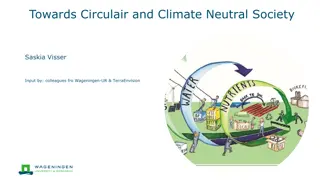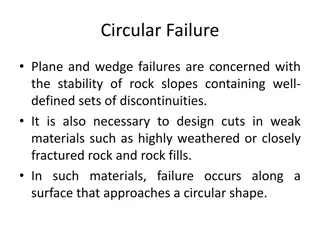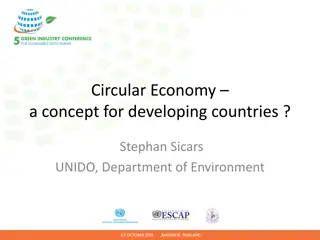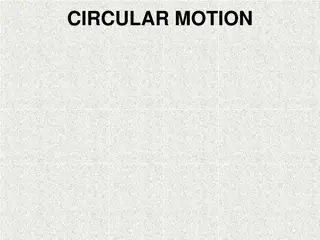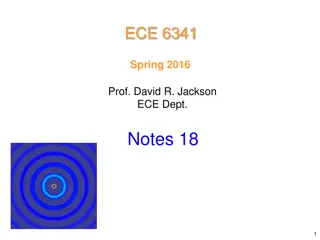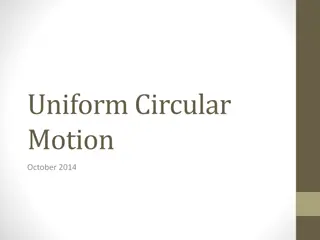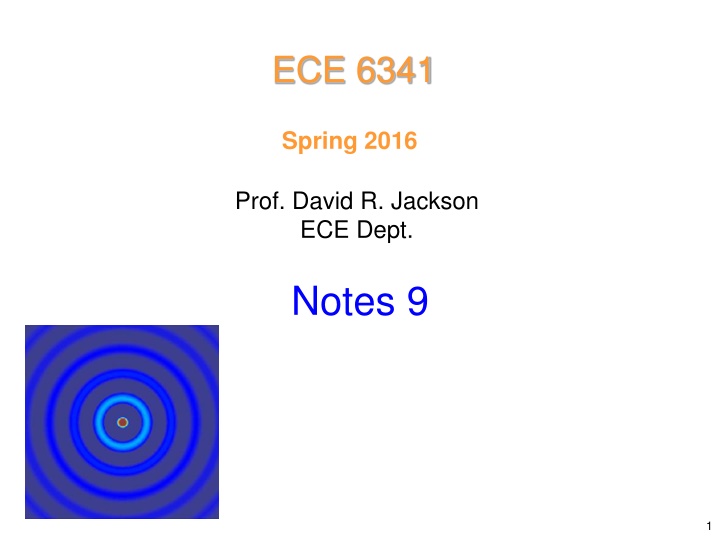
Circular Waveguides: Modes and Cutoff Frequencies
Explore the characteristics of circular waveguides, including TEz and TMz modes, cutoff frequencies, and TEz mode analysis. Learn about the uniqueness of solutions, field finiteness, and more in this comprehensive guide.
Download Presentation

Please find below an Image/Link to download the presentation.
The content on the website is provided AS IS for your information and personal use only. It may not be sold, licensed, or shared on other websites without obtaining consent from the author. If you encounter any issues during the download, it is possible that the publisher has removed the file from their server.
You are allowed to download the files provided on this website for personal or commercial use, subject to the condition that they are used lawfully. All files are the property of their respective owners.
The content on the website is provided AS IS for your information and personal use only. It may not be sold, licensed, or shared on other websites without obtaining consent from the author.
E N D
Presentation Transcript
ECE 6341 Spring 2016 Prof. David R. Jackson ECE Dept. Notes 9 1
Circular Waveguide The waveguide is homogeneously filled, so we have independent TEz and TMz modes. TMz mode: ( = a ) , , zA z r z ( ) J k sin( cos( ) = jk z e z ( ) ) Y k 2 = 2 2 z k k k 2
Circular Waveguide (cont.) [0,2 ] (1) variation + 2 , ) = ( , , ) = n ( , z z (uniqueness of solution) n cos( ) Choose ( ) J k n = jk z cos( ) n e z ( ) Y k n 3
Circular Waveguide (cont.) ( ) 0, ,z (2) The field should be finite on the z axis n Y k ( ) is not allowed = jk z cos( ) ( ) n J k e z n 2 = 2 2 z k k k 4
Circular Waveguide (cont.) ( ) , , = 0 z E a z (3) B.C. s: 2 1 = + 2 E k z 2 j z 1 ( ) = 2 2 z k k j 2 k = j ( , , ) a = 0 z so = ( ) 0 n J k a Hence 5
Circular Waveguide (cont.) = ( ) 0 n J k a Jn(x) Plot shown for n 0 xn3 x xn1 xn2 x = k a x np a = k np = Note: is not included since (trivial soln.) 0 0 = nx 0 J x n np a 6
Circular Waveguide (cont.) TMnp mode: = = jk z cos( ) 0,1,2 A n J x e n z z n np a 1/2 2 x np a = = 2 1,2,3,......... k k p z 7
Cutoff Frequency: TMz = 2 2 2 zk k k x np a = = zk = k k 0 x np a = 2 f c c = TM f x c np 2 a r 8
Cutoff Frequency: TMz (cont.) xnp values 0 1 2 3 4 5 p \ n 1 2.405 3.832 5.136 6.380 7.588 8.771 2 5.520 7.016 8.417 9.761 11.065 12.339 3 8.654 10.173 11.620 13.015 14.372 4 11.792 13.324 14.796 TM01, TM11, TM21, TM02, .. 9
TEz Modes ( ) = , , zF z = jk z cos( ) ( ) n J k e z n 2 k = H z j ( ) , , 0 a z Note: 10
TEz Modes (cont.) Set ( ) , , = 0 E a z 1 = E so = 0 = a Hence n J k a = ( ) 0 11
TEz Modes (cont.) n J k a = ( ) 0 Recall: 1 n = n ( ) ~ J x , 0,1,2,.... x n Jn' (x) Plot shown for n 1 n 2 ! n x'n3 x x'n1 x'n2 Note: p = 0 is not included (see next slide). np = k a x x np a = = 1,2,3,..... k p 12
TEz Modes (cont.) np = = jk z cos( ) 1,2, n J x e p z n a x = 0 Note: If p =0 np ( ) 0 np = = n 0 J x J 0 (trivial soln.) n n a ( ) np = = 00 1 J x J n = 0 0 a = = jk z jkz e e (trivial fields) z k = 0 13
Cutoff Frequency: TEz = 2 2 2 zk k k x zk = np a 0 = = k k x np a = 2 f c c np = TE f x c 2 a r 14
Cutoff Frequency:TEz x np values 0 1 2 3 4 5 p \ n 1 3.832 1.841 3.054 4.201 5.317 5.416 2 7.016 5.331 6.706 8.015 9.282 10.520 3 10.173 8.536 9.969 11.346 12.682 13.987 4 13.324 11.706 13.170 TE11, TE21, TE01, TE31, .. 15
TE11 Mode The dominant mode of circular waveguide is the TE11 mode. Electric field Magnetic field Image:TE10.gif Image:TE11.gif (from Wikipedia) TE11 mode of circular waveguide TE10 mode of rectangular waveguide The TE11 mode can be thought of as an evolution of the TE10 mode of rectangular waveguide as the boundary changes shape. 16
Attenuation Property of TE01 Mode Goal: We wish to study the high-frequency dependence of attenuation on frequency for circular waveguide modes, and show the interesting behavior of the TE01 mode (the loss decreases as frequency increases). 1 1 P P = = s R = d 2 c 2 f 1 2 = = 2 P R H dl 2 t d s ( ) =O C 2 1 1 F TEzMode: = H z z Assume that Fz is order 1 as the frequency increases. j 1 = 2 H k F z z j Recall that k is a constant. 17
Attenuation Property (cont.) 1 = O H z Note: = O (1) 0 0 n n ( ) k ( ) = = = H O O zk 0 n = 0 n 0 ( ) 1 ( ) ) 1 ( ) 1 = + P O O = + 0 P O O O d d 2 2 ( ( ) = 1/2 = O 3/2 O 18
Attenuation Property (cont.) From the TEz table: 1 F = = O (1) E E z e.g. 2 1 F = = O (1) H H z z e.g. j ( ) 1 f = P O Hence 19
Attenuation Property (cont.) Usual behavior for rectangular waveguides Hence ( ) =O 1/2 If n 0: c ( ) =O 3/2 If n = 0: Decreases with frequency! c Note: The mode TE0p mode can be supported by a series of concentric rings, since there is no longitudinal (z-directed) current (H = 0). E n = 0: H 20
Attenuation Property (cont.) c ( ) TM01 TE21 TM11 TE11 =O 1/2 c TE01 ( ) =O 3/2 c f fc, TE11 fc, TM01 fc, TE21fc, TE01 21
Attenuation Property (cont.) The TE01 mode was studied extensively as a candidate for long-range communications but was not competitive with antennas. Also, fiber-optic cables eventually became available with lower loss than the TE01 mode. It is still useful for some applications (e.g., high power). From the beginning, the most obvious application of waveguides had been as a communications medium. It had been determined by both Schelkunoff and Mead, independently, in July 1933, that an axially symmetric electric wave (TE01) in circular waveguide would have an attenuation factor that decreased with increasing frequency [44]. This unique characteristic was believed to offer a great potential for wide-band, multichannel systems, and for many years to come the development of such a system was a major focus of work within the waveguide group at BTL. It is important to note, however, that the use of waveguide as a long transmission line never did prove to be practical, and Southworth eventually began to realize that the role of waveguide would be somewhat different than originally expected. In a memorandum dated October 23, 1939, he concluded that microwave radio with highly directive antennas was to be preferred to long transmission lines. Thus, he wrote, we come to the conclusion that the hollow, cylindrical conductor is to be valued primarily as a new circuit element, but not yet as a new type of toll cable [45]. It was as a circuit element in military radar that waveguide technology was to find its first major application and to receive an enormous stimulus to both practical and theoretical advance. K. S. Packard, The Origins of Waveguide: A Case of Multiple Rediscovery, IEEE Trans. MTT, pp. 961-969, Sept. 1984. 22
Attenuation Property (cont.) VertexRSI's Torrance Facility is a leading supplier of antenna feed components for the various commercial and military bands. A patented circular polarized 4-port diplexer meeting all Intelsat specifications leads a full array of products. Products include: 4-Port Diplexers, CP or Linear; 3-Port Diplexers, 2xRx & 1xTx; 2-Port Diplexers, RxTx, X-Pol or Co-Pol, CP or Linear; TE21 Monopulse Tracking Couplers; TE01 Mode Components; Transitions; Filters; Flex Waveguides; Waveguide Bends; Twists; Runs; etc. Many of the items are "off the shelf products". Products can be custom tailored to a customer's application. Many of the products can be supplied with standard feed horns for prime or offset antennas. 23

